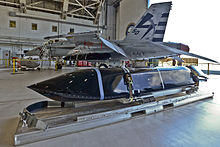AGM-158C LRASM

AGM-158C LRASM (Long Range Anti-Ship Missile) je autonomní podzvuková protilodní střela vyvíjená pro námořnictvo Spojených států amerických výzkumnou agenturou DARPA jako náhrada za střely Boeing Harpoon. Letové zkoušky střel byly plánovány na roky 2013–2014. Úspěšně byly zakončeny v únoru 2015.[1] Předpokládá se, že letecká verze střely vstoupí do služby roku 2016 a námořní roku 2018.[2]
V srpnu 2015 bylo letecké střele LRASM americkým námořnictvem přiděleno oficiální označení AGM-158C.[3]
Vývoj



Vývoj střely LRASM probíhá od roku 2009. DARPA na něm spolupracuje s americkým námořnictvem. Hlavním kontraktorem projektu je společnost Lockheed Martin. Cílem je vytvořit střelu dlouhého doletu schopnou pronikání nepřátelskou obranou za každého počasí a napadání hladinových i pozemních cílů v podmínkách silného rušení. Původní plány počítaly s vývojem dvou různých střel – podzvukové stealth střely LRASM-A s proudovým motorem a nadzvukové LRASM-B s kombinovaným raketovým a náporovým motorem (podobnou koncepci má například rusko-indický BrahMos). V lednu 2012 však byl vývoj střely LRASM-B zrušen a dále pokračují jen práce na verzi LRASM-A. Ta konstrukčně vychází z letecké protizemní střely AGM-158B JASSM-ER.[2]
Oproti střele JASSM má LRASM především novou navádecí hlavici (fungující v pasivním i aktivním režimu) a zesílenou konstrukci, umožňující její odpalování z vertikálních vypouštěcích sil Mk 41 na palubách lodí. Zavedena ovšem bude i verze nesená letadly (plánovaná je integrace do typů B-1B, B-2, B-52, F-15, F-16, F/A-18, F-35 a P-8).[4] Bojová hlavice WDU-42/B má hmotnost 450 kg. Střelu pohání proudový motor Williams F107-WR-105. Střela dosahuje nejvyšší rychlosti přes 927 km/h a její dolet by měl přesahovat 370 km.[2]
Společnost Lockheed Martin pro střelu vyvíjí čtyřnásobné odpalovací zařízení, které by bylo možné umístit na palubu lodí jako v případě staršího typu Harpoon. Tím by střela mohla být využita v rámci nového konceptu amerického námořnictva „Distributed Lethality“ (zvýšení počtu protilodních střel na palubách amerických válečných lodí).[5]
V červenci 2017 byla americkými ozbrojenými silami objednána sériová výroba střely LRASM. Objednáno bylo celkem 23 střel úvotní série Lot 1 tzv. nízkosériové počáteční výroby (LRIP - Low Rate Initial Production).[6]
Odkazy
Reference
- ↑ VICTOR, Nancy. February's top stories: UK's £859m Type 26 GCS deal, India's $16bn navy projects [online]. Naval-technology.com, 2015-03-05 [cit. 2015-03-14]. Dostupné online. (anglicky)
- ↑ a b c ZAJAC, Ivan. Střely LRASM – Perspektivní náhrada za Harpoony?. ATM. 2013, roč. 45, čís. 5, s. 96. ISSN 1802-4823.[Dále jen Zajac 2013]
- ↑ Lockheed Martin's LRASM Anti-Ship Missile Just Got its U.S. Navy Designation: AGM-158C [online]. Navyrecognition.com, rev. 2015-08-24 [cit. 2015-08-31]. Dostupné v archivu pořízeném dne 2015-08-31. (anglicky)
- ↑ Zajac 2013, s. 97.
- ↑ Exclusive: First Image of the Lockheed Martin LRASM Top Side Launcher [online]. Navyrecognition.com, rev. 2016-03-26 [cit. 2016-03-31]. Dostupné online. (anglicky)[nedostupný zdroj]
- ↑ US Navy, Air Force award Lockheed first Long Range Anti-Ship Missile production contract [online]. Navaltoday.com, rev. 2017-07-26 [cit. 2017-07-28]. Dostupné online. (anglicky)
Externí odkazy
 Obrázky, zvuky či videa k tématu LRASM na Wikimedia Commons
Obrázky, zvuky či videa k tématu LRASM na Wikimedia Commons - Long Range Anti-Ship Missile (LRASM), United States of America [online]. Naval-technology.com [cit. 2013-06-14]. Dostupné online. (anglicky)
Média použitá na této stránce
AGM-158 Joint Air-to-Surface Standoff Missile (JASSM)
MST 9301 U.S. Navy, 1994, 260 x 26 x 7 feet/79.25 x 7.92 x 2.13 meters target craft (25MM series) used for live-fire exercises as remote-controlled target ship. The Defense Advanced Research Projects Agency (DARPA) and the Office of Naval Research (ONR) are collaborating on the Long Range Anti-Ship Missile (LRASM) program, which successfully launched its first prototype on August 27, 2013.
Designed for both surface and air launch,LRASM seeks to develop an autonomous, precision-guided anti-ship standoff missile based on the successful Joint Air to Surface Standoff Missile Extended Range (JASSM-ER) system. LRASM aims to incorporate sensors and systems to create a stealthy and survivable subsonic cruise missile with reduced dependence on intelligence, surveillance and reconnaissance (ISR) platforms, network links and GPS navigation in electronic warfare environments. The program also focuses on precision lethality in the face of advanced countermeasures.
“This fully functional test is a significant step in providing the U.S. Navy and U.S. Air Force with a next-generation anti-ship missile capability,” said Artie Mabbett, DARPA program manager for LRASM. “This test is the culmination of the five-year development and integration of advanced sensors in an All-Up-Round (AUR) missile. It also represents the first time we’ve integrated advanced sensors and demonstrated the entire system, resulting in performance that substantially exceeds our current capabilities.”
DARPA designed the free-flight transition test demonstration to verify the missile’s flight characteristics and assess subsystem and sensor performance. Beyond the primary objectives of the free-flight transition, the test vehicle also detected, engaged and hit an unmanned 260-foot Mobile Ship Target (MST) with an inert warhead.
A B-1 bomber from the 337th Test and Evaluation Squadron conducted the mission from Dyess AFB, Tex., to the Point Mugu Sea Test Range off the coast of southern California. Once in position, the B-1 released the LRASM, which followed a pre-planned route towards the target. Approximately halfway to its destination, the weapon switched to autonomous guidance, in which it autonomously detected the moving MST and guided itself to hit the desired location on the target. A F/A-18 fighter from the Air Test and Evaluation Squadron (VX) 31 in China Lake, Calif., followed the weapon during the flight.
Lockheed Martin Missiles and Fire Control is the prime contractor for the demonstration of the LRASM weapon. BAE Systems’ Information and Electronic Systems Integration division is the prime contractor for the design and delivery of LRASM’s onboard sensor systems.A Long Range Anti-Ship Missile (LRASM) integrated on F/A-18E/F Super Hornet 12 August 2015 at NAS Patuxent River, Md.
A U.S. Navy Long Range Anti-Ship Missile (LRASM) in flight during a test event Dec. 8 off the Coast of California.



